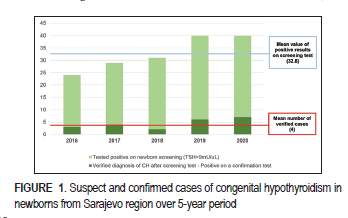Estimating neonatal screening for congenital hypothyroidism test performance
DOI:
https://doi.org/10.17532/jhsci.2022.1638Keywords:
Congenital hypothyroidism, Neonatal screening, ThyrotropinAbstract
Introduction: Newborn screening (NBS) is a system of organized search in the entire neonatal population for specific diseases. In Bosnia and Herzegovina, two diseases are included in NBS, congenital hypothyroidism (CH), and phenylketonuria. The screening for CH is based on determination of thyroid stimulating hormone (TSH) levels in blood obtained by heel prick method. The aim of this study is to evaluate the effectiveness of NBS program for CH based on TSH and establish the mean age of diagnosis of CH.
Methods: TSH was measured by time-resolved fluoroimmunoassay (DELFIA Neonatal hTSH kit). The TSH cutoff value was 9 μU/mL. Neonates with TSH < 9 μU/mL had a negative NBS result. Neonates with TSH ≥ 9 μU/mL were recalled for a confirmation test and thyroid hormones were determined from venous blood to establish diagnosis of CH.
Results: A total of 24,351 neonates were subjected to NBS in our institution. A total of 164 newborns with TSH ≥ 9 μU/ml were sent to additional testing (mean recall rate of 0.68%) at a mean age of 11.4 ± 0.5 days of life. In this group, diagnosis of CH was confirmed in 22 neonates (13.41%). The mean rate of false positive results of NBS was 0.59%. The incidence of CH in Sarajevo Canton ranged from 1/2477 in 2018 to 1/641 in 2020. The mean incidence of CH over a 5-year period was 1/1085, while the mean age at the time of diagnosis was 16.5 ± 1.2 days.
Conclusion: The analysis of NBS on congenital hypothyroidism data showed the satisfactory recall and false positive rate and indicated well selected TSH cutoff value. The mean age at the time of diagnosis assures early treatment and good neurological outcome in neonates with CH.
Downloads

Downloads
Published
Issue
Section
Categories
License
Copyright (c) 2022 Emina Hadžimuratović, Suada Branković, Admir Hadžimuratović, Sniježana Hasanbegović, Irmina Sefić-Pašić, Džan Ahmed Jesenković, Amila Hadžimuratović, Emina Opanković, Amila Agić

This work is licensed under a Creative Commons Attribution 4.0 International License.










